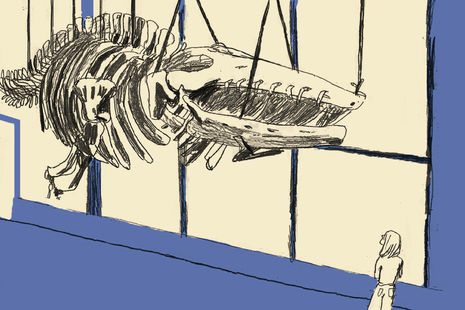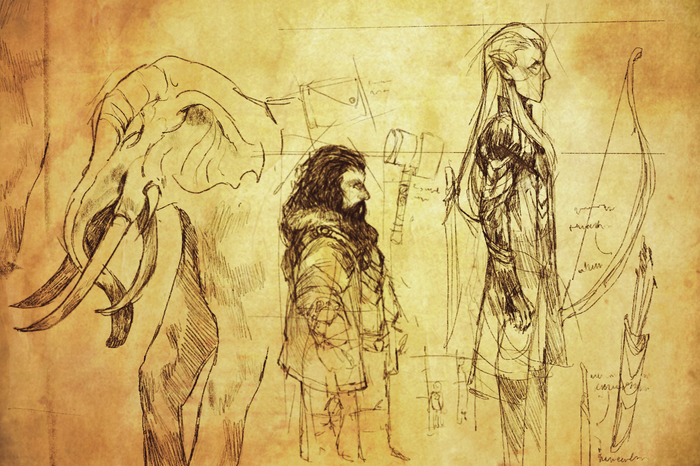Face to face with megafauna: in praise of the Museum of Zoology
Alicia Malkinson-Gregori takes a trip to the Museum of Zoology, and reflects on our relationship with nature, past and present

Turning the sharp corner into New Museums Site, you may have your eyes on the ground; absorbed with assignments, rushing to the next lecture, dodging cyclists and pedestrians alike. But look up for a moment, and you catch a glimpse of it: the Museum of Zoology’s twenty-one metre Fin Whale skeleton, arching along the ceiling of the Whale Hall in impossible flight. It’s a sight that never fails to cheer and chill me in equal measure. Belonging to the second largest extant animal species, the sheer size of the skeleton forces you to reckon with the unsettling smallness of our bodies. If we sit with this unease, we may find a place to be mindful, to set aside the worries of term and find comfort.
"The sheer size of the skeleton forces you to reckon with the unsettling smallness of our bodies"
Climbing the winding stairs and walking along the bridge to the café, we find ourselves at eye level with the great beast. A series of placards tell us about the specimen, found on a Sussex beach in 1865. One sign points us to look at the whale’s four-fingered ‘pentadactyl limb’. This forelimb, once attached to a rounded flipper, ends in a structure much like a hand, bodily evidence of our distant common ancestry. It seems we could not be more different, a tiny land-thing staring in the long dead eye of a sea monster, and considering our shared past takes effort. Meditate on it, and you might feel the strength of our belonging among all living things, the comfort of knowing that we’re surrounded by a strange and beautiful family.
In the museum’s basement, we find more skeletal megafauna. Take the charming Giant Ground Sloth: looking at its paws and squat back legs, it’s easy to imagine its lumbering walk. Like the whale, its skeleton is arranged as if in motion: the beast rears up, reaching as if to snag one of the large fruits on which it subsisted. Here we encounter another poetic turn of zoology, the tale of the ‘evolutionary ghost’. It has been suggested that these large fruits, seemingly unsuited to seed dispersal by extant animals, are the products of plants that adapted to appeal to the extinct megafauna. The giant sloth is the ghost here, missing from this crucial exchange. It haunts this earth still, its empty footprints still felt in our ecosystems.
"Here we encounter another poetic turn of zoology, the tale of the ‘evolutionary ghost’"
Much debate surrounds the circumstances of the megafaunal extinctions, which cluster in the late Pleistocene, 50,000-10,000 years ago. Previously proposed mechanisms included extraterrestrial impact and hyperdisease, but a review by Barnosky et al. (2004) makes a convincing case for the combined action of climate and hunting. The chronology links population decline across many megafaunal species to successive climate events, but also to the introduction and subsequent expansion of humans to new landmasses. Our giant ground sloth, an example of ‘naïve prey’ that had never experienced predation, was all too vulnerable.
A moving current exhibit highlights the voices of young students giving their perspectives on the museum’s collections. Sixth form students, brought together through a residential programme, designed their own descriptions for the fauna found in the museum. One student aptly calls the Large Blue Butterfly’s reintroduction to the UK “a story of disaster and hope”. It is this story that can be felt so strongly in every exhibit of this museum. The majestic Fin Whale, floating in air, reminds us of the size of our bodies and the size of our impacts. A vulnerable species, threatened increasingly by human activity, we feel keenly in this museum the tragedy its loss would be. Meanwhile, the Giant Ground Sloth tells a similar ‘story of disaster’, its extinction perhaps driven by early human hunting. But it is key not to neglect our simple love for nature, or the peace and mindfulness we can find from visiting this museum. In this building we have a chance to encounter Darwin’s ‘endless forms most beautiful and most wonderful’, and to reflect on how to protect our quiet family.
 Features / Beyond reality checkpoint: local businesses risking being forced out by Cambridge’s tourism industry15 October 2025
Features / Beyond reality checkpoint: local businesses risking being forced out by Cambridge’s tourism industry15 October 2025 Comment / Bonnie Blue is the enemy, not the face, of female liberation13 October 2025
Comment / Bonnie Blue is the enemy, not the face, of female liberation13 October 2025 News / Cambridge climbs to third in world Uni rankings11 October 2025
News / Cambridge climbs to third in world Uni rankings11 October 2025 News / Join Varsity this Michaelmas13 October 2025
News / Join Varsity this Michaelmas13 October 2025 Features / How to spend a Cambridge summer12 October 2025
Features / How to spend a Cambridge summer12 October 2025









